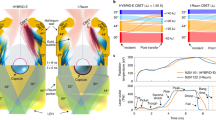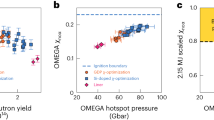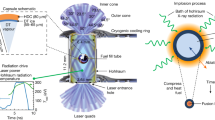Abstract
Alpha-particle self-heating, the process of deuterium–tritium fusion reaction products depositing their kinetic energy locally within a fusion reaction region and thus increasing the temperature in the reacting region, is essential for achieving ignition in a fusion system. Here, we report new inertial confinement fusion experiments where the alpha-particle heating of the plasma is dominant with the fusion yield produced exceeding the fusion yield from the work done on the fuel (pressure times volume change) by a factor of two or more. These experiments have achieved the highest yield (26 ± 0.5 kJ) and stagnation pressures (≍220 ± 40 Gbar) of any facility-based inertial confinement fusion experiments, although they are still short of the pressures required for ignition on the National Ignition Facility (∼300–400 Gbar). These experiments put us in a new part of parameter space that has not been extensively studied so far because it lies between the no-alpha-particle-deposition regime and ignition.
This is a preview of subscription content, access via your institution
Access options
Subscribe to this journal
Receive 12 print issues and online access
$209.00 per year
only $17.42 per issue
Buy this article
- Purchase on Springer Link
- Instant access to full article PDF
Prices may be subject to local taxes which are calculated during checkout




Similar content being viewed by others
References
Nuckolls, J. et al. Laser compression of matter to super-high densities: thermonuclear (CTR) applications. Nature 239, 139–142 (1972).
Lindl, J. D. et al. The physics basis for ignition using indirect-drive targets on the National Ignition Facility. Phys. Plasmas 11, 339–491 (2003).
Hurricane, O. A. et al. Fuel gain exceeding unity in an inertially confined fusion implosion. Nature 506, 343–348 (2014).
Döppner, T. et al. Demonstration of improved performance of fully-integrated deuterium–tritium capsule implosion in depleted uranium hohlraum on the NIF. Phys. Rev. Lett. 115, 055001 (2015).
Ma, T. et al. Thin-shell high-velocity ICF implosions on the National Ignition Facility. Phys. Rev. Lett. 114, 145004 (2015).
Callahan, D. et al. Higher velocity high-foot implosions on the National Ignition Facility. Phys. Plasmas 22, 056314 (2015).
Kozioziemski, B. J. et al. Deuterium–tritium layer formation for the National Ignition Facility. Fusion Sci. Tech. 59, 14–25 (2011).
Atzeni, S. & Meyer-ter-Vehn, J. The Physics of Inertial Fusion (Oxford Univ. Press, 2004).
Spitzer, L. & Harm, R. Transport phenomena in a completely ionized gas. Phys. Rev. 89, 977–981 (1953).
Lyon, S. P. & Johnson, J. D. Sesame: The Los Alamos National Laboratory Equation of State Database LA-UR-92-3407 (Los Alamos National Laboratory, 1995).
Krokhin, O. N. & Rozanov, V. B. Escape of α-particles from a laser-pulse-initiated thermonuclear reaction. Sov. J. Quant. Electron. 2, 393–394 (1973).
Town, R. P. J. et al. Dynamic symmetry of indirectly driven I. C. F. capsules on the National Ignition Facility. Phys. Plasmas 21, 056313 (2014).
Kritcher, A. L. et al. Metrics for long wavelength asymmetries in inertial confinement fusion implosions on the National Ignition Facility. Phys. Plasmas 21, 042708 (2014).
Lawson, J. D. Some criteria for a power producing thermonuclear reactor. Proc. Phys. Soc. 70, 6–10 (1957).
Gus’kov, S. Y., Krokhin, O. N. & Rozanov, V. B. Similarity solution of a thermonuclear burn wave with electron and α-conductivities. Nucl. Fusion 16, 957–962 (1976).
Atzeni, S. & Caruso, A. Inertial confinement fusion: ignition of isobarically compressed D-T targets. Nuovo Cimento B 80, 71–103 (1984).
Betti, R. et al. Deceleration phase of inertial confinement fusion implosions. Phys. Plasmas 9, 2277–2286 (2002).
Chang, P. Y. et al. Generalized measurable ignition criterion for inertial confinement fusion. Phys. Rev. Lett. 104, 135002 (2010).
Yeamans, C. et al. Enhanced NIF neutron activation diagnostics. Rev. Sci. Instrum. 83, 10D315 (2012).
Park, H.-S. et al. High-adiabat, high-foot, inertial confinement fusion implosion experiments on the National Ignition Facility. Phys. Rev. Lett. 112, 055001 (2014).
Hurricane, O. A. et al. The high-foot implosion campaign on the National Ignition Facility. Phys. Plasmas 21, 056314 (2014).
Volegov, P. et al. Neutron source reconstruction from pinhole imaging at the National Ignition Facility. Rev. Sci. Instrum. 85, 023508 (2014).
Patel, P. et al. Bull. Am. Phys. Soc. 55th Annu. Meeting APS Div. Plasma Phys. Vol. 58, 16 (American Physical Society, 2013); http://meetings.aps.org/link/BAPS.2013.DPP.NO4.1
Cerjan, C., Springer, P. T. & Sepke, S. M. Integrated diagnostic analysis of inertial confinement fusion capsule performance. Phys. Plasmas 20, 056319 (2013).
Bleuel, D. L. et al. Neutron activiation diagnostics at the National Ignition Facility. Rev. Sci. Instrum. 83, 10D313 (2012).
Gatu Johnson, M. et al. Neutron spectrometry—an essential tool for diagnosing implosions at the National Ignition Facility. Rev. Sci. Instrum. 83, 10D308 (2012).
Glenn, S. et al. A hardened gated X-ray imaging diagnostic for inertial confinement fusion experiments at the National Ignition Facility. Rev. Sci. Instrum. 81, 10E539 (2010).
Ma, T. et al. Imaging of high-energy X-ray emissions from cryogenic thermonuclear fuel implosions on the NIF. Rev. Sci. Instrum. 83, 10E115 (2012).
Merrill, F. E. et al. The neutron imaging diagnostic at NIF. Rev. Sci. Instrum. 83, 10D317 (2012).
Grim, G. P. et al. Nuclear imaging of the fuel assembly in ignition experiments. Phys. Plasmas 20, 056320 (2013).
Glebov, V. Yu et al. Development of nuclear diagnostics for the National Ignition Facility. Rev. Sci. Instrum. 77, 10E715 (2006).
Brysk, H. Fusion neutron energies and spectra. Plasma Phys. 15, 611–617 (1973).
Frenje, J. A. et al. Diagnosing implosion performance at the National Ignition Facility (NIF) by means of neutron spectrometry. Nucl. Fusion 53, 043014 (2013).
Murphy, T. J. The effect of turbulent kinetic energy on inferred ion temperature from neutron spectra. Phys. Plasmas 21, 072701 (2014).
Spears, B. K. et al. Bull. Am. Phys. Soc. 54th Annu. Meeting APS Div. Plasma Phys. Vol. 57, 12 (American Physical Society, 2012); http://meetings.aps.org/link/BAPS.2012.DPP.GO4.5
Betti, R. et al. Thermonuclear ignition in inertial confinement fusion and comparison with magnetic confinement. Phys. Plasmas 17, 058102 (2010).
Edwards, M. J. et al. Progress towards ignition on the National Ignition Facility. Phys. Plasmas 20, 070501 (2013).
Dittrich, T. R. et al. Design of a high-foot/high-adiabat ICF capsule for the National Ignition Facility. Phys. Rev. Lett. 112, 055002 (2014).
Meezan, N. B. et al. Cryogenic THD and DT layer implosions with high density carbon ablators in near-vacuum hohlraums. Phys. Plasmas 22, 062703 (2015).
Bosch, H. S. & Hale, G. M. Improved formulas for fusion cross-section and thermal reactivities. Nucl. Fusion 32, 611–631 (1992).
Acknowledgements
We gratefully acknowledge thoughtful discussions with R. Betti (LLE), D. Clark, J. Hammer, J. Hayes, M. C. Herrmann, W. Hsing, B. Kauffman, J. Kilkenny, R. Kirkwood, B. MacGowan, A. Mackinnon, N. Meezan, J. Nuckolls, L. Peterson, J. Pino, K. Raman, B. A. Remington, M. Rosen, V. Smalyuk, C. Thomas and B. Van Wonterghem. Thanks to the NIF’s operations, diagnostics, cryogenics, target, and project engineering teams (B. Burr, P. Kervin, L. Kot, J. Meeker, D. Swift and B. Young). Thanks to external collaborators at LANL (diagnostics), GA (targets), LLE (diagnostics), the MIT Plasma Science and Fusion Center (MRS diagnostic), CEA and AWE. This work was performed under the auspices of the US Department of Energy by Lawrence Livermore National Laboratory under Contract No. DE-AC52-07NA27344.
Author information
Authors and Affiliations
Contributions
O.A.H. high-foot (HF) team co-lead dynamic model development and synthesis; D.A.C. HF team co-lead hohlraum drive and symmetry; D.T.C. DT shots (experiments) co-RI (responsible individual); E.L.D. 1DConA (velocity measurement) Shot RI, re-emit (X-ray re-emission experiment) Shot RI and data analysis and hot-electron analysis; T.R.D. 1D design physics and scoping; T.D. DT Shot RI and hard X-ray imaging analysis; S.H. DT ice layer characterization and instability growth-factor calculations; D.E.H. integrated hohlraum–capsule pulse-shape design physics and integrated post-shot modelling; L.F.B.H. keyhole (shock wave timing) shot pulse-shape design and post-shot modelling; O.J. hohlraum model design and development; A.L.K. integrated post-shot modelling and asymmetry analysis; S.L. keyhole Shot RI; T.M. DT Shot RI and hotspot shape analysis; A.G.M. capsule X-ray yield, data analysis tools, and 1DConA co-RI; J.L.M. hohlraum model development and re-emit design; J.M. hohlraum and backscatter physics experiments; A.P. DT Shot co-RI, re-emit Shot RI and analysis, and hotspot shape analysis; H.-S.P. DT Shot RI; P.K.P. post-shot data analysis and hotspot model energy, pressure, and alpha-heating analysis; J.E.R. Symcap (hotspot symmetry measurement) Shot RI and backscatter analysis; H.F.R. keyhole platform design and hot-electron studies; J.S.R. hohlraum experiments; J.D.S. 1D post-shot modelling; B.K.S. development model database for alpha-heating analysis and NToF data analysis; P.T.S. hotspot, dynamic model development, and fit of Qcond to SESAME database; R.T. 1DConA shot co-RI, data analysis and unfold of 2DConA data; F.A. FFLEX (hot-electron) data analysis; L.R.B. time-resolved hotspot shape X-ray measurement; R.B. FNADS (nuclear activation) spatial analysis; E.B. NToF data analysis; D.K.B. 2DConA (ablator shape) platform development; J.C. NToF data analysis; P.M.C. keyhole VISAR data analysis; C.C. 3D hotspot model analysis; J.A.C. GRH (gamma reaction history); R.D.S. DT ice layer cryogenics; D.E. south-pole bang-time data analysis; M.J.E. Program Director; D.F. NIS (neutron imaging system) LLNL RS (responsible scientist); M.A.B.G. 2DConA Shot RI; A.H. target fabrication engineering; R.H. NToF data analysis; H.H. GRH data analysis; M.H. FFLEX data synthesis; D.H. target engineering; J.L.K. Symcap Shot RI and Dante (low-resolution X-ray temperature measurement) analysis; B.K. DT ice layer cryogenics and cryo-team science lead; G.K. X-ray imaging and analysis; G.G. fields and performs data analysis for the neutron imaging time-of-flight system; J.E.F. 2DConA data analysis; J.F. MRS (magnetic recoil spectrometer) diagnostic analysis; N.I. X-ray image data analysis; M.G.J. MRS diagnostic analysis; S.F.K. X-ray image analysis; J.K. nuclear data analysis; T.K. DT fuelling and tritium facility lead; O.L. fuel velocity inference; F.M. NIS LANL RS and performs data reduction, analysis, and error determination; P.M. hohlraum cross-bean energy transfer model and analysis; A.M. Dante diagnostic RS; S.R.N. 2DConA Shot co-RI, DIXI X-ray data analysis; A.N. target fabrication engineering; T.P. cryogenics and DT fuel team; R.R.R. 2DConA data analysis; D.S. GRH; M.S. soft X-ray imaging analysis; D.S. spectral radio-chemistry data analysis; D.S. backscatter analysis; R.P.J.T. 2DConA platform design; A.W. high energy density program lead; K.W. Dante diagnostic RS; C.W. NIS diagnostic RI; P.V. develops algorithms to extract source information from NIS coded aperture; C.Y. FNADS (flange nuclear activation diagnostic system) analysis.
Corresponding author
Ethics declarations
Competing interests
The authors declare no competing financial interests.
Rights and permissions
About this article
Cite this article
Hurricane, O., Callahan, D., Casey, D. et al. Inertially confined fusion plasmas dominated by alpha-particle self-heating. Nature Phys 12, 800–806 (2016). https://doi.org/10.1038/nphys3720
Received:
Accepted:
Published:
Issue Date:
DOI: https://doi.org/10.1038/nphys3720
This article is cited by
-
Simulation study of cone-in-shell target for indirect-drive ion fast ignition concept under the theory of an effective interaction potential
Scientific Reports (2023)
-
Focused Energy, A New Approach Towards Inertial Fusion Energy
Journal of Fusion Energy (2023)
-
Burning plasma achieved in inertial fusion
Nature (2022)
-
A quasi-monoenergetic short time duration compact proton source for probing high energy density states of matter
Scientific Reports (2021)
-
Observation of a high degree of stopping for laser-accelerated intense proton beams in dense ionized matter
Nature Communications (2020)



